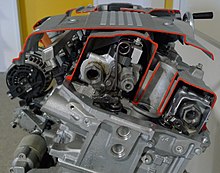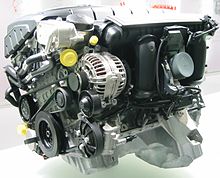|
BMW N52
The BMW N52 is a naturally aspirated straight-6 petrol engine which was produced from 2004 to 2015. The N52 replaced the BMW M54 and debuted on the E90 3 Series and E63 6 Series. The N52 was the first water-cooled engine to use magnesium/aluminium composite construction in the engine block.[1] It was also listed as one of Ward's 10 Best Engines in 2006 and 2007.[2][3][4] In European markets, the N52 began to be phased out in favor of its direct injected version, the BMW N53 in 2007. Markets such as the United States, Canada, Australia and Malaysia retained the N52 as the N53 was deemed unsuitable due to the high sulphur content of local fuel.[5] The N52 and N53 are the last naturally aspirated straight-six engines produced by BMW, ending a history of continuous production of this engine configuration since the BMW M30 in 1968. In 2011, the N52 began to be replaced by the BMW N20 turbocharged four-cylinder engine. N52 production ceased in 2015.[6] Unlike its predecessors, there is no BMW M version of the N52. Design Compared with its M54 predecessor, the N52 features Valvetronic (variable valve lift),[7] a lighter block due to the use of a magnesium alloy[8] and an electric water pump (replacing the belt-driven water pump)[9][10] and a variable output oil pump.[11] The redline was increased from 6,500 rpm to 7,000 rpm, except for N52B25 (130 kW).[12] Like the M54, the N52 uses electronic throttle control and variable valve timing (double-VANOS). Higher output versions of the N52 use a three-stage variable length intake manifold (also called "DISA").[13][14] The N52 engine block is made from a combination of magnesium and aluminium.[12] Magnesium is lighter than aluminium, however it has a greater risk of corrosion from water and may creep under load at high temperatures; this makes traditional magnesium alloys not suited for withstanding the high loads to which an engine block is exposed. Therefore, BMW used a magnesium alloy for the crankcase shell, with an aluminum 'inner block' to overcome the limitations of magnesium alloys.[11][15] The cylinder liners are made of Alusil.[16] The N52 debuted with solid cast intake and exhaust camshafts, but during production hollow "hydro-formed" camshafts were phased in to reduce weight.[11] Some engines came from the factory equipped with one solid and one hollow camshaft as the solid shaft was being phased out. Engine performance is not affected by installation of mixed camshafts. The engine control unit (also called "DME") is a Siemens MSV70.[12] Models    
N52B25130 kW (174 bhp) Applications:[17][18] 150 kW (201 bhp) Applications: 160 kW (215 bhp) Applications:
N52B30The 3.0 L (183 cu in) models of the N52 have a bore of 85 mm (3.35 in), a stroke of 88 mm (3.46 in) and a compression ratio of 10.7:1. Variations in power output are often due to different intake manifolds and variations of engine management software.[19] 160 kW (215 bhp) Applications:[20]
170 kW (228 bhp) Applications:
180 kW (241 bhp) Applications:[21][22]
190 kW (255 bhp) Applications:[23]
195 kW (261 bhp) Applications: 200 kW (268 bhp) Applications:[24]
N51B30The N51 engine is a SULEV version of the N52 that was sold in parts of the United States that had SULEV legislation.[25] Differences to the N52 versions include a variable-length intake manifold ("DISA") with three stages instead of one, and a compression ratio lowered from 10.7:1 to 10.0:1.[26] Recalls
See alsoReferences
|
|||||||||||||||||||||||||||||||||||||||||||||||||||||||||||||||||||||||||||
Portal di Ensiklopedia Dunia
